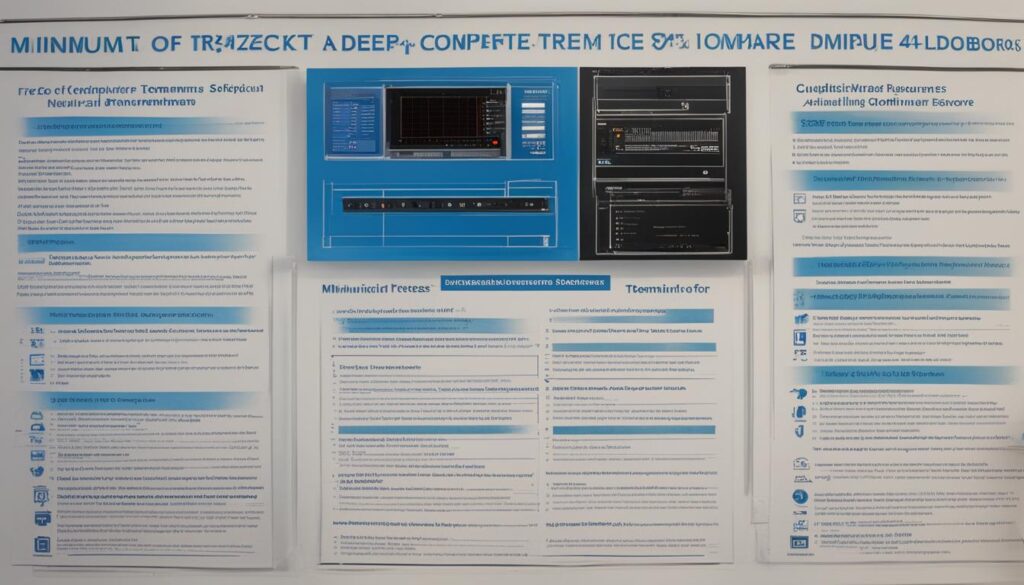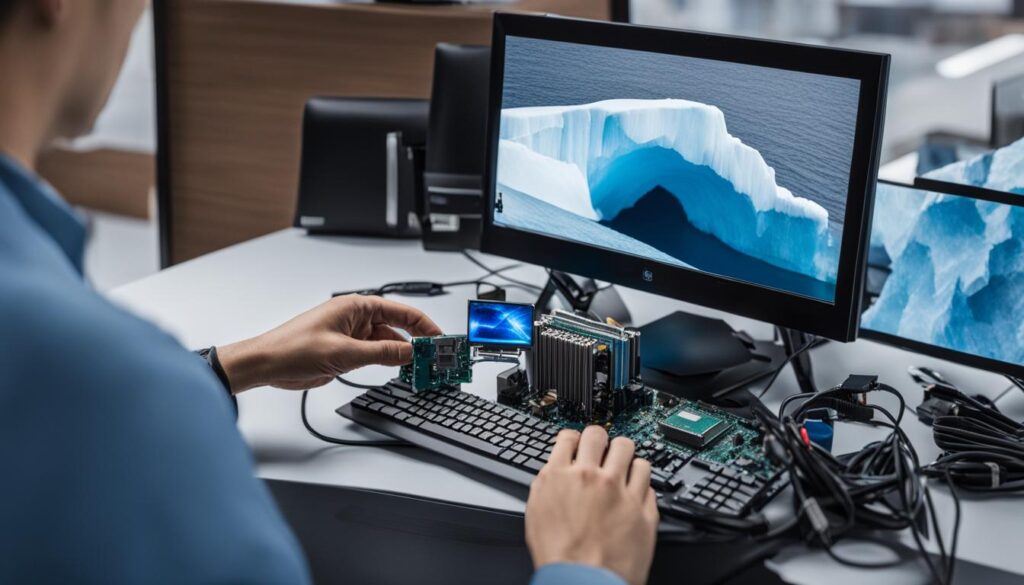Deep Freeze in information technology is a software solution that helps manage and protect computer systems by preserving their desired configuration. It allows for the “freezing” of a computer’s state, preventing any changes from being permanently saved. This ensures system integrity and eliminates the need for constant reimaging or troubleshooting. Deep Freeze is widely used by IT professionals to maintain system stability and reduce maintenance costs.
Contents
- 1 Benefits of Deep Freeze
- 2 Features of Deep Freeze
- 3 System Requirements for Deep Freeze
- 4 Installing Deep Freeze
- 5 Using Deep Freeze
- 6 Maintenance and Uninstalling Deep Freeze
- 7 Conclusion
- 8 FAQ
- 8.1 What is Deep Freeze in information technology?
- 8.2 What are the benefits of Deep Freeze?
- 8.3 What are the features of Deep Freeze?
- 8.4 What are the system requirements for Deep Freeze?
- 8.5 How do I install Deep Freeze?
- 8.6 How do I use Deep Freeze?
- 8.7 How do I maintain and uninstall Deep Freeze?
- 8.8 What are the final thoughts on Deep Freeze?
- 9 Source Links
Key Takeaways:
- Deep Freeze is a software solution that preserves the desired configuration of computer systems.
- It “freezes” the state of a computer, preventing permanent changes and ensuring system integrity.
- Its purpose is to simplify system maintenance, reduce troubleshooting, and lower maintenance costs.
- Deep Freeze is widely used by IT professionals to maintain system stability and security.
- By understanding Deep Freeze, IT professionals can optimize system management and protect data.
Benefits of Deep Freeze
Deep Freeze offers several benefits in information technology. Its usage provides significant advantages for system management and data protection.
Prevents Configuration Drift and System Misconfiguration
One of the key benefits of Deep Freeze is its ability to eliminate configuration drift and accidental system misconfiguration. With Deep Freeze in place, any changes made to the system are temporary and do not persist after a reboot. This ensures that the system always reverts back to its desired configuration, preventing any unwanted changes or errors.
Protects Against Malware and Malicious Software
Deep Freeze acts as a safeguard against malware and other malicious software. As the system state is frozen, any malware or viruses that infect the computer are automatically removed upon reboot. This prevents the permanent installation of harmful software and safeguards the system against potential data breaches or security threats.
Reduces IT Workload and Enhances System Availability
IT professionals can benefit from reduced workload when using Deep Freeze. With the system’s configuration and stability ensured, there is minimal time spent on troubleshooting and reimaging. This allows IT teams to focus on more strategic tasks and ensures that system availability is maximized for end-users.
Enables Data Protection and Work Continuity
“Deep Freeze allows me to work on my projects without worrying about accidental data loss. Even if I make a mistake, I know that my work is always saved and protected.” – John Smith, IT Consultant
Deep Freeze enables users to save their work on frozen systems without the fear of data loss. Whether it’s an important document, a crucial presentation, or critical project files, users can rest assured that their work is secure and easily accessible. This promotes work continuity and eliminates the risk of data loss due to system issues or user errors.
Overall, Deep Freeze provides numerous benefits for information technology. It eliminates configuration drift, protects against malware, reduces IT workload, and ensures data protection and work continuity. With its usage, system maintenance becomes simpler and more efficient, allowing IT professionals to focus on strategic initiatives and improving overall productivity.
Take a look at the table below for a summarized overview of the benefits of Deep Freeze:
| Benefits of Deep Freeze |
|---|
| Eliminates configuration drift and accidental system misconfiguration |
| Protects against malware and malicious software |
| Reduces IT workload and enhances system availability |
| Enables data protection and work continuity |
Features of Deep Freeze
Deep Freeze offers a comprehensive range of features that enhance system management and security. Whether you’re an IT professional or an end-user, these features provide you with the tools you need to maintain a stable and secure computer environment. Let’s explore some of the key features of Deep Freeze:
- Automated System Updates: Deep Freeze allows for automated system updates, including updates for Windows and Mac operating systems, even when protection is enabled. This ensures that your computer remains up to date with the latest security patches and software enhancements.
- Scheduled Software Updates: Administrators have the flexibility to schedule updates for other software as well. By defining specific update times, you can ensure that important software components are kept up to date without interrupting critical tasks.
- Data Retention: Deep Freeze provides options for data retention across system reboots. This feature enables users to store important data on non-system drives or network locations, ensuring that valuable files are preserved even after the computer restarts.
- Rapid Deployment: Deep Freeze simplifies the deployment process through an intuitive enterprise console or a command-line interface. This streamlined approach allows IT professionals to efficiently manage Deep Freeze across multiple systems, saving time and effort.
- Standard Configuration: Deep Freeze helps maintain a consistent and standardized configuration across all workstations connected over a network. By ensuring that all computers have the same settings and software versions, you can eliminate compatibility issues and reduce troubleshooting efforts.
These features showcase the power and versatility of Deep Freeze in preserving the desired state of your computer systems. With automated system updates, data retention options, and seamless deployment capabilities, Deep Freeze empowers you to effectively manage and secure your computer environment.
Unlock the Full Potential of Deep Freeze
Deep Freeze offers a multitude of features that cater to the needs of both IT professionals and end-users alike. By understanding how these features work together, you can harness the full potential of Deep Freeze to ensure system stability, simplify maintenance tasks, and protect your valuable data.
System Requirements for Deep Freeze
To use Deep Freeze, your system must meet certain requirements to ensure optimal performance and compatibility. Here are the system requirements for installing and running Deep Freeze:
- Operating System: Deep Freeze is compatible with Windows operating systems, including Windows 7, 8.1, 10, and 11.
- System Memory: A minimum of 8 GB of system memory is recommended to ensure smooth operation and efficient usage of Deep Freeze.
- Hard Drive Space: Deep Freeze requires at least 10% free hard drive space to install and function properly.
Note: Deep Freeze is currently incompatible with the Core Isolation feature of Windows. You must manually disable this feature before installing Deep Freeze to avoid any conflicts.
By meeting these system requirements, you can ensure that Deep Freeze integrates seamlessly with your host operating system, allowing you to enjoy the benefits of this powerful software.
For a visual representation of the system requirements for Deep Freeze, refer to the table below:
| System Requirements | Specifications |
|---|---|
| Operating System | Windows 7, 8.1, 10, and 11 |
| System Memory | Minimum 8 GB |
| Hard Drive Space | At least 10% free space |

By ensuring that your system meets these requirements, you can make the most of Deep Freeze’s capabilities and enjoy a seamlessly protected and managed IT environment.
Installing Deep Freeze
Installing Deep Freeze is a straightforward process that can be completed by following a few simple steps:
-
Begin by executing the installation file. This will initiate the Deep Freeze installation wizard, which will guide you through the installation process.
-
Before proceeding with the installation, it is recommended to disable any background utilities and anti-virus software running on your system. Additionally, close all applications to ensure a smooth installation.
-
During the installation, you will be prompted to agree to the license agreement. Take a moment to review the terms and conditions, and if you agree, proceed to the next step.
-
Next, you will need to enter the license key or choose the evaluation mode if you don’t have a license key yet. This step is crucial for activating Deep Freeze and ensuring its functionality.
-
After entering the license key or selecting the evaluation mode, you will have the option to select the drives you wish to freeze. By freezing a drive, you ensure that any changes made to its contents will be automatically reverted upon system restart.
-
Furthermore, you can create a ThawSpace during the installation process. A ThawSpace is a designated area on your system where you can store data that you want to keep even after a reboot. This allows for flexibility and convenience while using Deep Freeze.
-
Finally, the installation process will ensure that Deep Freeze is correctly set up on your system. Once the installation is completed, you will have access to the powerful features and benefits that Deep Freeze provides.
With Deep Freeze successfully installed on your system, you can now enjoy the benefits of system stability, data protection, and simplified maintenance that this software offers.
Take a look at the installation process in the diagram below:
 |
Using Deep Freeze
Once Deep Freeze is installed, you have complete control over its management and configuration. The user-friendly interface allows you to effortlessly access various features and settings. Let’s explore some of the key functionalities:
Boot Control
With Deep Freeze, you can dictate the behavior of your system during boot-up. You have the option to boot directly into the Frozen state, keeping your system protected and secure. Alternatively, you can choose to boot into a Thawed state, providing unrestricted access to the operating system and installed programs.
Logging
Deep Freeze provides comprehensive logging capabilities to help you keep track of system events and user activities. The detailed logs can be a valuable resource for troubleshooting and analyzing system performance. Whether you need to investigate any issues or simply monitor system usage, the logging feature has you covered.
Password Protection
Safeguard your Deep Freeze settings and prevent unauthorized access by setting up a secure password. By enabling password protection, you can ensure that only authorized users can modify Deep Freeze configurations, providing an additional layer of security to your system.
“Deep Freeze gives you the power to control your system’s boot behavior, keep track of system events through detailed logs, and protect your settings with a secure password.”
Deep Freeze is designed with simplicity and intuitiveness in mind. Whether you are an IT administrator or an end-user, you can quickly grasp its functionalities and leverage them effectively. Its user-friendly interface empowers you to effortlessly manage and maintain system stability, all while enjoying the benefits of a secure and hassle-free computing environment.

Now that you have a good understanding of how to use Deep Freeze, let’s explore its maintenance and uninstallation procedures in the next section.
Maintenance and Uninstalling Deep Freeze
Once Deep Freeze is properly installed, it requires minimal maintenance on your part. The software automatically preserves and maintains your desired system configuration, eliminating the need for constant manual adjustments. This ensures that your system remains stable and consistent, saving you time and effort in the long run.
However, if you ever need to uninstall Deep Freeze, there are specific steps you can follow to ensure a clean removal. You have two options for uninstallation: using the installer or utilizing the Deep Freeze console.
To uninstall Deep Freeze using the installer, follow these steps:
- Locate the Deep Freeze installation file on your computer.
- Double-click the installation file to launch the uninstallation wizard.
- Follow the on-screen prompts to uninstall Deep Freeze.
If you prefer to uninstall Deep Freeze through the Deep Freeze console, here’s what you need to do:
- Open the Deep Freeze console on your computer.
- Select the workstation or group that you want to uninstall Deep Freeze from.
- Click on the “Uninstall Deep Freeze” option.
- Follow the instructions provided to complete the uninstallation process.
Properly uninstalling Deep Freeze ensures that your system is returned to its original state, with all associated files removed. This allows you to fully remove the software and restore your computer to its pre-Deep Freeze configuration.

Conclusion
As an IT professional, understanding Deep Freeze in information technology is crucial for maintaining system integrity and simplifying maintenance tasks. Deep Freeze offers a plethora of benefits, including enhanced system stability, robust data protection, and reduced workload for IT teams. With its advanced features like automated updates and rapid deployment, Deep Freeze streamlines system management and strengthens overall security.
By meeting the specified system requirements and following the recommended installation and maintenance guidelines, you can fully leverage the power of Deep Freeze. Ensuring trouble-free maintenance and a secure IT environment becomes effortless. Deep Freeze provides a reliable solution for preserving desired system configurations, protecting against malware, and eliminating the need for constant troubleshooting or reimaging.
In conclusion, Deep Freeze is an invaluable asset for IT professionals. By implementing this software, you can maintain a standardized configuration, safeguard critical data, and reduce the complexity of managing computer systems. Embrace Deep Freeze to enjoy the convenience it brings to your IT operations and experience a seamless maintenance process.
FAQ
What is Deep Freeze in information technology?
Deep Freeze is a software solution that helps manage and protect computer systems by preserving their desired configuration.
What are the benefits of Deep Freeze?
Deep Freeze offers several benefits, including eliminating configuration drift, protecting against malware, reducing IT workload, and ensuring system availability and data protection.
What are the features of Deep Freeze?
Deep Freeze offers features such as automated system updates, data retention options, rapid deployment, and the ability to maintain a standard configuration across a network.
What are the system requirements for Deep Freeze?
Deep Freeze is compatible with Windows operating systems, requires a minimum of 8 GB of system memory, and needs at least 10% free hard drive space. It is currently incompatible with the Core Isolation feature of Windows.
How do I install Deep Freeze?
To install Deep Freeze, you need to execute the installation file, agree to the license agreement, enter the license key, select the drives to freeze, and create a ThawSpace for storing data.
How do I use Deep Freeze?
With Deep Freeze, you can freeze and thaw system states, access the operating system and installed programs, and manage settings such as boot control, logging, and password protection.
How do I maintain and uninstall Deep Freeze?
Deep Freeze requires minimal maintenance but can be uninstalled from the installer or through the Deep Freeze console to restore the system to its original state.
What are the final thoughts on Deep Freeze?
Deep Freeze is a valuable tool for IT professionals, providing system integrity, simplified maintenance, and a secure IT environment.




